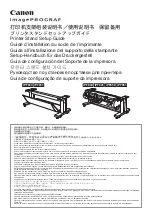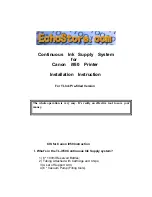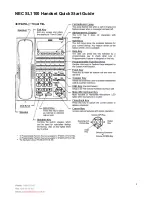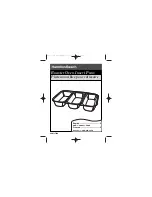
page 23
Switch to a 1/16" bit and, centering on the point just created,
drill through the top and into the plywood support block
and the neck block. These are the holes for the mounting
screws. Remove the strings, the L-support, and the neck.
Remove the neck and fingerboard and enlarge the four holes
in the metal top with the 1/8” bit. De-burr the inside and out-
side of the holes drilled in the metal, and also de-burr the
underside of the fingerboard extension, so that all the pieces
screw together firmly without gaps. Install the four finger-
board mounting screws. Don’t install the dot inlays over the
screws yet.
Note:
Depending upon how deep you drilled the flat bot-
tom 1/4" holes for the dot inlays, and depending upon the
hardness of the fingerboard, you may need to drill a smaller
secondary hole — using a standard twist drill bit with a
beveled face — as a slight countersink for the screw head. A
7/32" drill bit works well.
Be careful!
Drilling these holes in
the fingerboard with a hand drill is tricky. It’s easy to drill
through the fingerboard by mistake. Practice on scrap, and
be alert.
Re-install the neck and all the other parts, and then string the
guitar to pitch. Under string tension, fasten the fingerboard
extension to the top using the four screws and plywood fin-
gerboard support on the inside. Remove the strings so you
can level the frets.
With masking tape and heavy paper, tape off the top around
the fretboard to protect it from your fret leveling tools. With
the peghead resting on the tabletop for gentle support,
adjust the neck perfectly straight
(38)
, until a straightedge
rests on all the frets (don’t expect it to rest on the fingerboard
extension over the body, because it will fall away slightly).
If you happen to find a high fret, tap it down before leveling.
Support the back of the neck under the fret that you are
hammering on.
TIP:
You can use masking tape on each side of the
frets to protect the fretboard from sanding. Use a
wide tip blue felt marker to color the tops of all the
frets. This allows you to follow your leveling
progress and know when the sandpaper has hit the
tops of all the frets evenly.
Use 320-grit sandpaper double-stick taped to the narrow
edge of a long flat surface
(39)
(we used a carpenter’s level).
You’ll need to lightly sand the fingerboard extension sepa-
rately with a smaller sanding block, since it falls away from
the level plane of the main fingerboard.
When all of the tops have been dulled by sanding (the blue
marks will disappear), round the tops of the frets. As a sand-
ing tool, find a 1/2"-thick foam rubber sanding pad, or other
piece of resilient material and round over one edge with a
rasp. Wrap 320-grit sandpaper around the edge and work the
sandpaper lengthwise from along the fingerboard, with even
pressure. Hold the sander on edge to shape the fret ends and
smooth the edges of the fretboard.
Change grits, working up to at least 800. You will end up with
round fret tops that are nicely polished. Vacuum off the metal
dust.
The neck is ready to be removed, final-sanded, and finished.
Glue in the nut now.
Reinstalling the neck and leveling the frets
38.
Adjust the neck perfectly straight, until a straightedge rests on
all the frets.
39.
Use 240-grit or finer sandpaper double-stick taped to the nar-
row edge of a long flat surface.





































